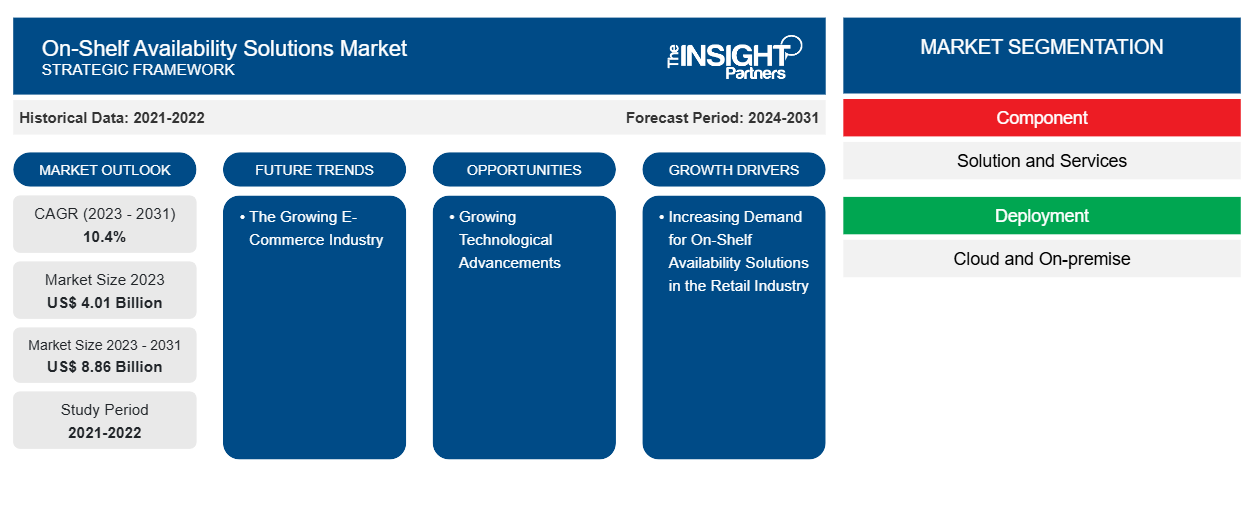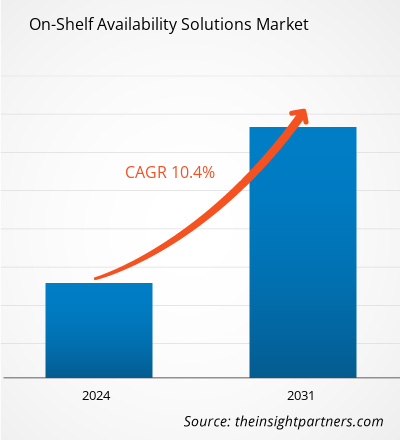The on-shelf availability solutions market size is projected to reach US$ 8.86 billion by 2031 from US$ 4.01 billion in 2023. The market is expected to register a CAGR of 10.4% in 2023–2031. The growing e-commerce industry is likely to remain a key on-shelf availability solutions market trend.
On-Shelf Availability Solutions Market Analysis
The growing number of retail stores worldwide is raising the demand for on-shelf availability solutions in the retail industry, which is one of the major factors fueling the growth of the market. In addition, the growing demand for omni-channel solutions and the rising focus on customer experience are driving the growth of the market. Furthermore, the growing integration of advanced technology such as AI, ML, computer vision, and others is creating an opportunity for the growth of the on-shelf availability solutions market in the coming years.
On-Shelf Availability Solutions Market Overview
On-shelf availability refers to the presence of a product on a store's shelves when a customer arrives to purchase it. On-shelf availability guarantees that customers may easily and hassle-free buy the product they desire. For the retailer, it ensures consumer happiness as well as greater revenue from product sales. On-shelf availability helps manufacturers too, as it guarantees sales of their goods and offers useful information for inventory control. As a result, in the retail sector, on-shelf availability is a crucial factor that must be effectively monitored and maintained.
Customize This Report To Suit Your Requirement
You will get customization on any report - free of charge - including parts of this report, or country-level analysis, Excel Data pack, as well as avail great offers and discounts for start-ups & universities
On-Shelf Availability Solutions Market: Strategic Insights

-
Get Top Key Market Trends of this report.This FREE sample will include data analysis, ranging from market trends to estimates and forecasts.
On-Shelf Availability Solutions Market Drivers and Opportunities
Increasing Demand for On-Shelf Availability Solutions in the Retail Industry
The fundamentals of store operations continue to be a challenge for many retailers, frequently because they are unable to interpret the data they do have or do not have access to the necessary information to make improvements. To cater to this problem, retailers are adopting on-shelf availability solutions. This solution can help retailers to provide customer satisfaction and increase revenue through the sale of the product. In addition, it helps retailers to improve brand reputation and foster a more positive company culture. Thus, all the above factors are raising the demand for on-shelf availability solutions in the retail industry, driving the growth of the market.
Growing Technological Advancements
Manual shelf management requires high manpower costs, and it is mostly carried out at a defined frequency. To solve this problem, various market players are continuously working on integrating advanced technologies such as AI, computer vision, and others. Integrating the technologies can automatically help to detect OOS items, incorrect placements, and other issues by identifying, classifying, and inventorying shelf items using algorithms such as price tag recognition, product recognition, OOS detection, activity recognition, and optical character recognition (OCR). Thus, such technological advancements can create an opportunity for market growth in the forecasted period.
On-Shelf Availability Solutions Market Report Segmentation Analysis
Key segments that contributed to the derivation of the on-shelf availability solutions market analysis are component, deployment, and end user.
- Based on component, the market is bifurcated into solution and services. The solution segment held a larger market share in 2023.
- By deployment, the market is segmented into cloud and on-premise. The cloud segment held the largest share of the market in 2023.
- By end user, the market is segmented into CPG manufacturers, retailers, suppliers, and others. The CPG manufacturers segment held the largest share of the market in 2023.
On-Shelf Availability Solutions Market Share Analysis by Geography
The geographic scope of the on-shelf availability solutions market report is mainly divided into five regions: North America, Asia Pacific, Europe, Middle East & Africa, and South America/South & Central America.
In terms of revenue, North America accounted for the largest on-shelf availability solutions market share. The market in this region is segmented into the US, Canada, and Mexico. The region is witnessing a tremendous rise in its E-commerce sector, which is one of the main factors fueling the growth of the market. In addition, the region consists of highly developed retail and supply chain sectors, which is further contributing to the rise in demand for on-shelf availability solutions in North America.
On-Shelf Availability Solutions Market Regional Insights
The regional trends and factors influencing the On-Shelf Availability Solutions Market throughout the forecast period have been thoroughly explained by the analysts at The Insight Partners. This section also discusses On-Shelf Availability Solutions Market segments and geography across North America, Europe, Asia Pacific, Middle East and Africa, and South and Central America.
On-Shelf Availability Solutions Market Report Scope
| Report Attribute | Details |
|---|---|
| Market size in 2023 | US$ 4.01 Billion |
| Market Size by 2031 | US$ 8.86 Billion |
| Global CAGR (2023 - 2031) | 10.4% |
| Historical Data | 2021-2022 |
| Forecast period | 2024-2031 |
| Segments Covered |
By Component
|
| Regions and Countries Covered |
North America
|
| Market leaders and key company profiles |
|
On-Shelf Availability Solutions Market Players Density: Understanding Its Impact on Business Dynamics
The On-Shelf Availability Solutions Market is growing rapidly, driven by increasing end-user demand due to factors such as evolving consumer preferences, technological advancements, and greater awareness of the product's benefits. As demand rises, businesses are expanding their offerings, innovating to meet consumer needs, and capitalizing on emerging trends, which further fuels market growth.

- Get the On-Shelf Availability Solutions Market top key players overview
On-Shelf Availability Solutions Market News and Recent Developments
The On-Shelf Availability Solutions Market is evaluated by gathering qualitative and quantitative data post primary and secondary research, which includes important corporate publications, association data, and databases. The following is a list of developments in the market for speech and language disorders and strategies:
- Retail Velocity, the pioneer and industry leader in consumer demand and supply data management, reporting, and analytics, announced the launch of the 10th generation of its VELOCITY platform and the introduction of VELOCITY Essential. This new VELOCITY Pro 10 delivers increased performance, easier data management, enhanced reporting, and additional security, allowing consumer goods manufacturers to gain deeper actionable insights faster than ever; make more-informed, collaborative decisions internally and with retailer partners; and quickly and effectively address changing consumer demand and market conditions. (Source: Retail Velocity, Press Release, 2022)
- Tredence Inc., a leading data science and AI engineering company announced a partnership with Databricks, the leader in unified analytics founded by the original creators of Apache Spark. Under this partnership, the companies jointly built the On-Shelf Availability Solution (OSA) accelerator that helps retailers and manufacturers solve out-of-stock by combining Databricks’ data processing capabilities and Tredence’s expertise in AI/ML. (Source: Tredence Inc, Press Release, 2021)
On-Shelf Availability Solutions Market Report Coverage and Deliverables
The “On-Shelf Availability Solutions Market Size and Forecast (2021–2031)” report provides a detailed analysis of the market covering below areas:
- Market size and forecast at global, regional, and country levels for all the key market segments covered under the scope
- Market dynamics such as drivers, restraints, and key opportunities
- Key future trends
- Detailed PEST/Porter’s Five Forces and SWOT analysis
- Global and regional market analysis covering key market trends, major players, regulations, and recent market developments
- Industry landscape and competition analysis covering market concentration, heat map analysis, prominent players, and recent developments
- Detailed company profiles
Frequently Asked Questions
What will be the market size of the global on-shelf availability solutions market by 2031?
Which are the key players holding the major market share of the global on-shelf availability solutions market?
What are the driving factors impacting the global On-shelf availability solutions market?
What is the estimated market size for the global on-shelf availability solutions market in 2023?
What are the future trends of the global on-shelf availability solutions market?
- Historical Analysis (2 Years), Base Year, Forecast (7 Years) with CAGR
- PEST and SWOT Analysis
- Market Size Value / Volume - Global, Regional, Country
- Industry and Competitive Landscape
- Excel Dataset
Recent Reports
Testimonials
Reason to Buy
- Informed Decision-Making
- Understanding Market Dynamics
- Competitive Analysis
- Identifying Emerging Markets
- Customer Insights
- Market Forecasts
- Risk Mitigation
- Boosting Operational Efficiency
- Strategic Planning
- Investment Justification
- Tracking Industry Innovations
- Aligning with Regulatory Trends





















 Get Free Sample For
Get Free Sample For